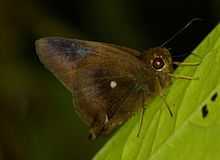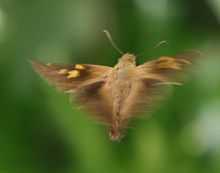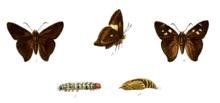Hasora badra
| Common Awl | |
|---|---|
 | |
 | |
| Scientific classification | |
| Kingdom: | Animalia |
| Phylum: | Arthropoda |
| Class: | Insecta |
| Order: | Lepidoptera |
| Family: | Hesperiidae |
| Genus: | Hasora |
| Species: | H.badra |
| Binomial name | |
| Hasora badra (Moore, 1857)[1] | |
Hasora badra,[2][3] commonly known as the Common Awl, is a butterfly belonging to the family Hesperiidae, which is found in India.
Description

- For a key to the terms used see the glossary of Lepidopteran terms.
_at_23_mile_near_Jayanti_in_Duars%2C_West_Bengal_W_IMG_5849.jpg)
The butterfly, which has a wingspan of 50 to 55mm, is dark brown unmarked above. The butterfly, resembles the Common Banded Awl Hasora chromus, except that it has no white band below; and the apex of the forewing and the disc of the hindwing below are purple-washed. The male has apical spots but no brands above. The female has large yellow spots in cell, 2 and 3, and apical dots.[4][5]
The Sri Lankan race has no apical spots on the male above and no purple-wash below.[4][5]
Detailed description
Watson (1891) [6] gives a detailed description, shown below:
- Male and female yellowish brown.
- Male, with a suffused blackish subbasal patch; forewing with three conjugated very small yellowish semitransparent spots near the costa, one fourth from the apex. Cilia pale greyish brown. Underside brown suffused with purple; forewing with a blackish costal patch before the apex, posterior margin yellowish; hindwing with a subbasal and submarginal suffused blackish band, the latter terminating in a black patch on anal lobe; above the patch is a purple-white streak, and within the cell a small bluish white spot. Palpi and body beneath dull yellow. Legs, pale brown.
- Female, above brown suffused with vinaceous yellowish brown basally; forewing with the three small subapical spots (as in male) and three rather large obliquely quadrate spots, two being disposed on the disc, the third above and within the cell. Underside with the spots on forewing as in upperside; hindwing as in male.
Range
The butterfly is found in Sri Lanka, India, Myanmar, Thailand, Laos, Hainan, Taiwan, North Vietnam, Japan, Western China, Malaysia, the Indonesian archipelago (Borneo, Sumatra, and Java), Philippines, Palawan, Moluccas and Sulawesi.[3][7]
In India the butterfly is found in South India, where it occurs in the Western Ghats, and the Nilgiris; and in the Himalayas from Mussoorie eastwards to Sikkim and through to Myanmar. It is also found in the Andaman and Nicobar islands.[3][4]
Status
Not Rare as per Evans (1932).[7]
Host-plants
The larva has been recorded on Derris uliginosa, Milletia pachycarpa and Pongamia spp.[3]
Cited references
- ↑ Card for Hasora badra in LepIndex. Accessed 12 October 2007.
- ↑ TOL web page on genus Hasora
- ↑ 3.0 3.1 3.2 3.3 3.4 Marrku Savela's Website on Lepidoptera. Page on genus Hasora.
- ↑ 4.0 4.1 4.2 Wynter-Blyth, M.A. (1957) Butterflies of the Indian Region, pg 468.
- ↑ 5.0 5.1 Kunte, Krushnamegh. (2000) Butterflies of Peninsular India, pg 192.
- ↑ Watson, E. Y. (1891) Hesperiidae indicae. Vest and Co. Madras.
- ↑ 7.0 7.1 Evans,W.H.(1932) The Identification of Indian Butterflies, ser no I1.7, pg 314.
References
- Evans, W.H. (1932) The Identification of Indian Butterflies. 2nd Ed, (i to x, pp454, Plates I to XXXII), Bombay Natural History Society, Mumbai, India.
- Kunte, Krushnamegh. (2000) Butterflies of Peninsular India, (i to xviii, pp254, Plates 1 to 32) Universities Press (India) Ltd, Hyderabad (reprint 2006). ISBN 81-7371-354-5.
- Watson, E. Y. (1891) Hesperiidae indicae. Vest and Co. Madras.
- Wynter-Blyth, M.A. (1957) Butterflies of the Indian Region, Bombay Natural History Society, Mumbai, India.
Online
- Beccaloni, G. W., Scoble, M. J., Robinson, G. S. & Pitkin, B. (Editors). 2003. The Global Lepidoptera Names Index (LepIndex). World Wide Web electronic publication. (accessed 22 September 2007).
- Brower, Andrew V. Z., (2007). Hasora Moore 1881. Version 21 February 2007 (under construction). Page on genus Hasora in The Tree of Life Web Project http://tolweb.org/.
- Savela, Marrku Website on Lepidoptera (accessed 22 September 2007)